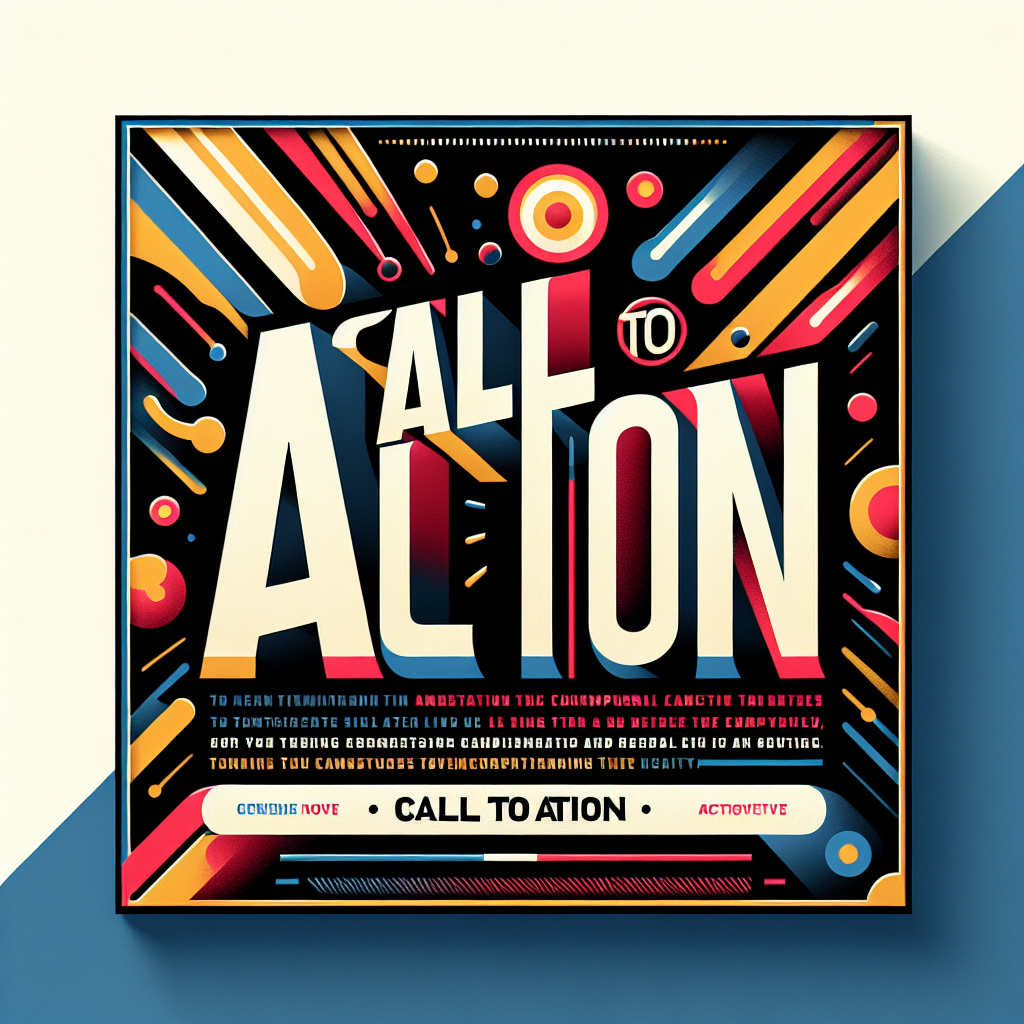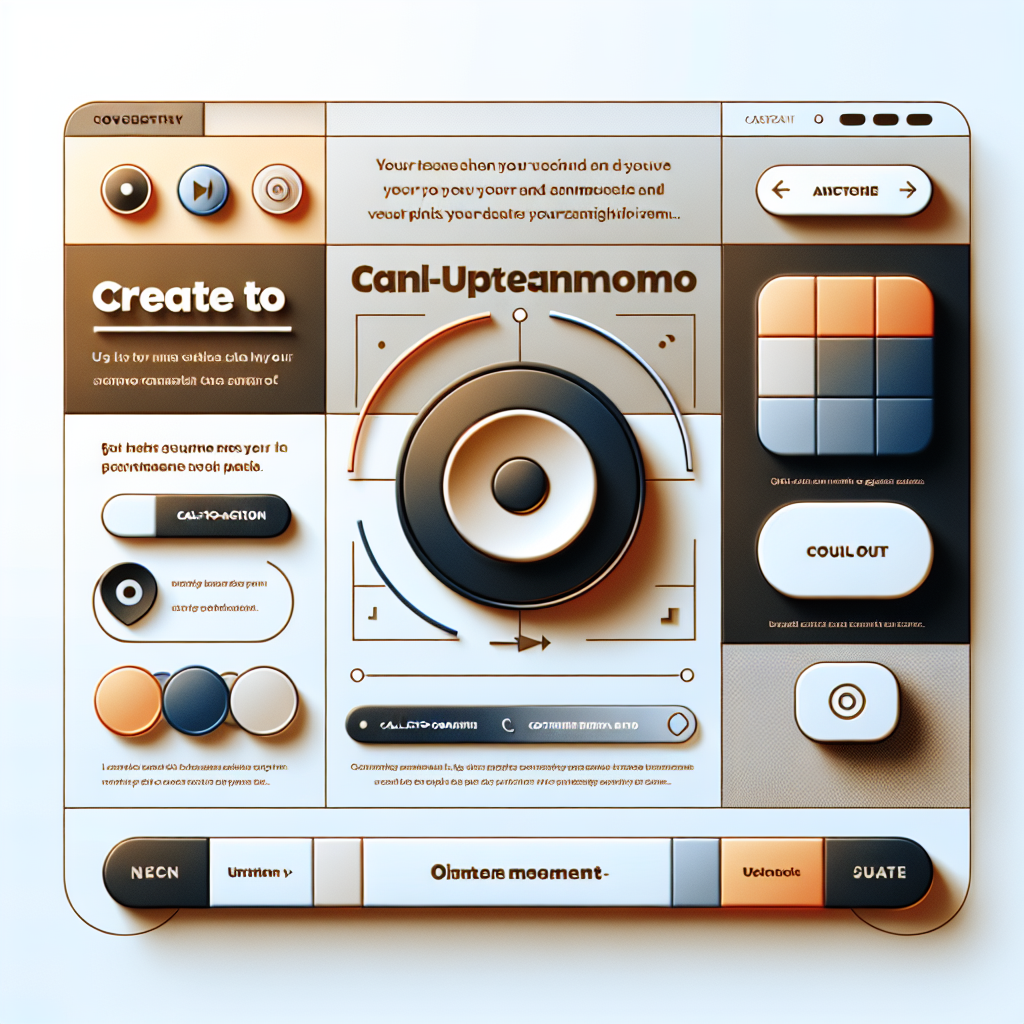In the world of digital marketing, a call to action (CTA) is one of the most crucial elements. It serves as a guiding beacon that directs your audience towards the desired action, whether it’s making a purchase, signing up for a newsletter, or downloading an eBook. A well-crafted CTA can significantly boost your conversion rates and amplify the effectiveness of your marketing campaigns.
But what exactly makes a CTA effective? It’s more than just a button or a link; it’s a strategic tool that, when used correctly, can turn potential customers into loyal clients. A compelling CTA needs to be clear, concise, and action-oriented. It should create a sense of urgency and offer a tangible benefit to the user. The language used should be persuasive yet straightforward, making it easy for the user to understand what they are getting and why they should act now.
Moreover, the design of your CTA plays a vital role. Utilizing contrasting colors, eye-catching fonts, and strategic placement on your website or landing page can make a significant difference. Remember, the goal is to make it as easy as possible for your audience to take the next step.
At Guru-is.com, we specialize in crafting visually stunning and highly effective CTAs that drive real business success. Ready to transform your website? Get a quote today and see the difference!
Understanding the Importance of CTAs

The significance of a well-constructed call to action (CTA) cannot be overstated in the realm of digital marketing. CTAs act as the critical junction between visitor engagement and conversion, guiding users from passive browsing to taking decisive actions. Without effective CTAs, even the most beautifully designed website with compelling content can fall short in driving conversions.
One of the primary reasons CTAs are so essential is that they provide clear instructions to your audience. In a digital landscape saturated with information, users appreciate direct and straightforward guidance on what to do next. This clarity can reduce decision-making friction and lead to higher conversion rates.
Additionally, CTAs contribute to the overall user experience by creating a seamless path towards the desired action. They help maintain the flow of the user’s journey on your website, ensuring that visitors do not feel lost or overwhelmed. By strategically placing CTAs at key points within your content, you can keep users engaged and encourage them to move deeper into your sales funnel.
The impact of CTAs extends beyond mere clicks. They are valuable tools for gathering data and insights about user behavior. Analyzing the performance of different CTAs can offer valuable information about what resonates with your audience, allowing you to fine-tune your marketing strategies and improve future campaigns.
In essence, understanding the importance of CTAs is crucial for anyone looking to optimize their digital presence. A well-placed, thoughtfully designed CTA can mean the difference between a visitor who simply browses and one who becomes a loyal customer.
Types of Effective Calls to Action

There are various types of effective calls to action (CTAs) that businesses can utilize to engage their audience and drive conversions. Each type serves a unique purpose and can be strategically employed based on the goals of your campaign and the behavior of your target audience.
1. Lead Generation CTAs: These are designed to capture potential customers’ information, such as email addresses, through forms or subscriptions. Examples include ‘Sign Up for Our Newsletter’ or ‘Download Our Free E-book.’
2. Social Sharing CTAs: These encourage visitors to share your content on social media platforms, thereby increasing your reach and visibility. Examples include ‘Share This Article’ or ‘Tweet This.’
3. Purchase CTAs: Direct and straightforward, these CTAs encourage immediate purchases. Examples include ‘Buy Now’ or ‘Add to Cart.’
4. Click-Through CTAs: These are designed to direct users to another page within your website, often a product page or a landing page. Examples include ‘Learn More’ or ‘Read More Details.’
5. Event Promotion CTAs: Used to drive registrations for webinars, workshops, or live events. Examples include ‘Register Now’ or ‘Join Our Webinar.’
6. Feedback or Survey CTAs: These are aimed at collecting user feedback or conducting surveys to gather insights. Examples include ‘Take Our Survey’ or ‘Give Us Your Feedback.’
7. Free Trial or Demo CTAs: These encourage users to try your product or service without any initial cost. Examples include ‘Start Your Free Trial’ or ‘Request a Demo.’
Understanding the different types of CTAs and when to use them can significantly enhance your marketing strategy. By matching the right CTA to your specific goals and audience behavior, you can create a more engaging and effective user experience.
Crafting Compelling CTA Copy

Creating compelling CTA copy is an art that combines clarity, urgency, and relevance to motivate users to take action. Here are some essential tips to help you craft CTAs that convert:
1. Be Clear and Direct: Your CTA should leave no room for ambiguity. Use straightforward language that clearly states what you want the user to do. For instance, ‘Download Now’ or ‘Sign Up Today’ are clear and actionable.
2. Use Action-Oriented Verbs: Start your CTA with strong, commanding verbs that prompt immediate action. Words like ‘Get,’ ‘Download,’ ‘Start,’ and ‘Join’ can make your CTA more persuasive.
3. Create a Sense of Urgency: Incorporate words that convey urgency to encourage immediate action. Phrases like ‘Limited Time Offer,’ ‘Act Now,’ or ‘Only a Few Spots Left’ can drive users to act quickly.
4. Highlight Benefits: Clearly communicate the value or benefit the user will gain by clicking on the CTA. Instead of just ‘Sign Up,’ you could say ‘Sign Up to Get Exclusive Updates.’
5. Keep It Short and Sweet: Effective CTAs are typically short and to the point. Aim for a concise message that can be quickly understood and acted upon.
6. Personalize When Possible: Tailoring your CTA to the individual user can increase relevance and engagement. Using phrases like ‘Get Your Free Report’ or ‘Start Your Personalized Plan’ makes the action feel more customized.
7. Test and Optimize: A/B testing different versions of your CTA copy can provide insights into what works best for your audience. Regularly review performance metrics and tweak your copy to improve effectiveness.
By focusing on these key elements, you can craft compelling CTA copy that not only grabs attention but also drives action, ultimately leading to higher conversion rates and better business outcomes.
Designing Visually Appealing CTAs
While the text in your call to action (CTA) is crucial, the design also plays a significant role in capturing attention and encouraging clicks. Here’s how you can design visually appealing CTAs that stand out:
1. Use Contrasting Colors: Choose colors that contrast with the rest of your webpage. This makes your CTA button pop and draws the user’s eye directly to it. For instance, if your website’s primary color is blue, a bright orange or yellow CTA button would be eye-catching.
2. Ensure Readability: The text on your CTA button should be easily readable. Use large, bold fonts and ensure there is enough contrast between the text color and the button color.
3. Make It Noticeable: Position your CTA in a place where it naturally draws attention. Common placements include above the fold, at the end of blog posts, or in the middle of content where it makes logical sense.
4. Add White Space: Surround your CTA with ample white space to make it stand out. Crowded designs can overwhelm users, making the CTA less noticeable.
5. Use Shapes and Icons: Incorporating shapes like arrows or icons can make your CTA more engaging. These elements can subtly guide the user’s eye towards the action you want them to take.
6. Keep It Consistent: While your CTA should stand out, it should also align with your brand’s overall design. Consistency in color schemes, fonts, and style helps maintain a cohesive look and feel.
7. Test Different Designs: Just like with CTA copy, A/B testing various design elements can help determine what resonates best with your audience. Experiment with different colors, sizes, and placements to optimize performance.
Effective CTA design balances aesthetics with functionality. By focusing on these design principles, you can create visually appealing CTAs that not only attract attention but also drive users to take the desired action.
Testing and Optimizing Your CTAs

Once you’ve crafted and designed your call to action (CTA), the next crucial step is to test and optimize it for maximum effectiveness. This process involves analyzing user interactions to identify what works best for your audience and making data-driven adjustments. Here’s how to get started:
1. A/B Testing: Conduct A/B tests by creating two or more versions of your CTA with variations in text, color, size, placement, or design. Measure which version performs better in terms of click-through rates (CTR) and conversions.
2. Analyze Click-Through Rates (CTR): Monitor the CTR of your CTAs to understand how many users are engaging with them. A low CTR might indicate that the CTA is not compelling enough or not noticeable.
3. Use Heatmaps: Heatmap tools can provide visual data on where users are clicking on your webpage. This information helps you understand if your CTA is placed in an optimal location or if it needs repositioning.
4. Experiment with Copy: Test different wording in your CTAs to see what resonates most with your audience. Sometimes a simple tweak in the phrasing can significantly impact performance.
5. Optimize for Mobile: Ensure your CTAs are mobile-friendly. Test how they appear and function on various devices to provide a seamless user experience across all platforms.
6. Track Conversion Rates: Beyond clicks, measure the actual conversions resulting from your CTAs. This helps you assess the overall effectiveness and return on investment (ROI) of your CTA strategy.
7. Iterate Based on Data: Use the insights gathered from your testing to make informed adjustments. Continuous iteration and optimization are key to maintaining effective CTAs that adapt to changing user behaviors and preferences.
Testing and optimizing your CTAs is an ongoing process that requires attention to detail and a willingness to experiment. By leveraging data and user feedback, you can fine-tune your CTAs to drive higher engagement and conversions. Ready to enhance your website’s CTAs? Get a quote at https://guru-is.com/#contact and let us help you achieve absolute web success for your business!

